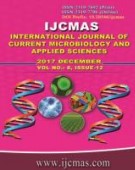


 National Academy of Agricultural Sciences (NAAS)
National Academy of Agricultural Sciences (NAAS)

|
PRINT ISSN : 2319-7692
Online ISSN : 2319-7706 Issues : 12 per year Publisher : Excellent Publishers Email : editorijcmas@gmail.com / submit@ijcmas.com Editor-in-chief: Dr.M.Prakash Index Copernicus ICV 2018: 95.39 NAAS RATING 2020: 5.38 |
Fruits and vegetables are one of the essential diets of human being, which they are consumed widely. But, they are contaminated with different bacteria that may cause food borne illness. Bacteriological survey of 20 samples of fresh vegetables and fruits were done to study the density of microorganisms by standard plate count (SPC) method. The colony forming units per gram (cfu/g) of the vegetables were much less (7.2x105 to 30.4x105) in local market sample as compared to super market sample (12.0x105 to 20.6x105) and field sample (8.0x105 to 18.0x105). But in case of fruits higher cfu were obtained for the field sample (8x105) as compared to local market sample (4x105 to 5.5x105) and super market sample (2.5x105). Of the various pathogens identified from the surface of these samples Escherichia coli, Staphylococcus aureus, Bacillus cerous were found to be the pre-dominant species in most of the samples. It was observed that the Bacillus, Enterobacter and Staphylococcus were the dominant genera in vegetables. On the basis of antimicrobial rinsing of carrot, which was carrying the highest bacterial contamination, five different anti-microbial agents (Hydrogen peroxide, Sodium chloride, Calcium chloride, Sodium citrate and Ethanol) decreased the total number of microbial organisms’ load of the carrot by 40-80 per cent. Hydrogen peroxide was, however, found to be the most effective, as rinsing treatment with it showed more reduction in total number of bacterial organisms in 80 per cent of samples. Hydrogen peroxide can thus be used as rinsing agent to reduce this type of superficial bacterial contamination so as to improve the quality of fresh vegetables and fruits for human consumption. The microflora of fruits and vegetables are one of the great concerns in our society as they can be of great risk for human health. Proper handling, hygiene, transportation and proper storage is necessary to avoid microbial food spoilage and related health risks.
 |
 |
 |
 |
 |